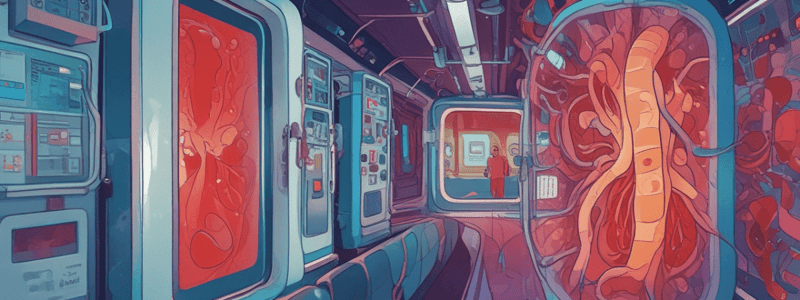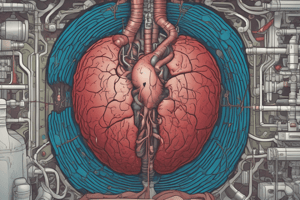Podcast
Questions and Answers
What is a common complication of urosepsis?
What is a common complication of urosepsis?
- Pleural effusion
- Pulmonary embolism
- Cardiac tamponade
- Disseminated intravascular coagulation (correct)
What is the main mechanism of paraneoplastic syndromes?
What is the main mechanism of paraneoplastic syndromes?
- Metastatic spread of tumor cells
- Invasion of surrounding tissues by tumor cells
- Immune-mediated destruction of normal tissues
- Secretion of tumor products and immunologic cross-reactivity (correct)
What is the estimated frequency of paraneoplastic syndromes in malignant tumors?
What is the estimated frequency of paraneoplastic syndromes in malignant tumors?
- 5-10%
- 1-20% (correct)
- 1-5%
- 20-50%
What is the name of the syndrome characterized by sterile thrombi along the closing edge of heart valves?
What is the name of the syndrome characterized by sterile thrombi along the closing edge of heart valves?
What is the name of the disease characterized by metabolic derangement usually seen 48-72 hours after initial treatment of lymphoma or leukemia?
What is the name of the disease characterized by metabolic derangement usually seen 48-72 hours after initial treatment of lymphoma or leukemia?
What is the term for the systemic effects of tumors not due to invasion, metastasis, or obstruction?
What is the term for the systemic effects of tumors not due to invasion, metastasis, or obstruction?
What is the name of the disease characterized by immune-mediated disease following allogeneic stem cell transplantation?
What is the name of the disease characterized by immune-mediated disease following allogeneic stem cell transplantation?
What is the term for the microthrombi that occur in disseminated intravascular coagulation?
What is the term for the microthrombi that occur in disseminated intravascular coagulation?
What is the term for the inflammatory changes that occur in the urinary tract in urosepsis?
What is the term for the inflammatory changes that occur in the urinary tract in urosepsis?
What is the term for the macroscopic changes that occur in the liver in chronic hepatitis?
What is the term for the macroscopic changes that occur in the liver in chronic hepatitis?
Which condition can lead to the development of MODS?
Which condition can lead to the development of MODS?
In an autopsy case involving suspected sepsis and shock, which of the following findings would most likely be present?
In an autopsy case involving suspected sepsis and shock, which of the following findings would most likely be present?
Which microorganism is least likely to cause sepsis in the presence of bronchopneumonia?
Which microorganism is least likely to cause sepsis in the presence of bronchopneumonia?
Which statement about the relationship between sepsis, SIRS, and MODS is accurate?
Which statement about the relationship between sepsis, SIRS, and MODS is accurate?
Which of the following describes how neoplasia might relate to MODS?
Which of the following describes how neoplasia might relate to MODS?
Which of the following is NOT a characteristic of the progressive phase of shock?
Which of the following is NOT a characteristic of the progressive phase of shock?
What is the most common cause of death in noncoronary intensive care units?
What is the most common cause of death in noncoronary intensive care units?
Which of the following is a clinical manifestation of septic shock?
Which of the following is a clinical manifestation of septic shock?
Which of the following is NOT a predisposing factor to SIRS?
Which of the following is NOT a predisposing factor to SIRS?
Which of the following is a hallmark of the irreversible phase of shock?
Which of the following is a hallmark of the irreversible phase of shock?
Which of the following is NOT a common primary site of infection in sepsis?
Which of the following is NOT a common primary site of infection in sepsis?
Which of the following is a histologic finding associated with shock?
Which of the following is a histologic finding associated with shock?
Which of the following is a common macroscopic finding in patients with septic shock?
Which of the following is a common macroscopic finding in patients with septic shock?
What is the most common type of pneumonia acquired in the intensive care unit (ICU)?
What is the most common type of pneumonia acquired in the intensive care unit (ICU)?
Which of the following is NOT a risk factor for infective endocarditis?
Which of the following is NOT a risk factor for infective endocarditis?
Flashcards are hidden until you start studying
Study Notes
Multiple Organ Dysfunction Syndrome (MODS)
- Defined as an acute and serious illness in which two or more organ systems stop functioning properly
- Can be caused by trauma, infection/sepsis, or disease
Sepsis and Shock
- Shock: Inability to meet cellular metabolic requirements due to global hypoperfusion
- SIRS (Systemic Inflammatory Response Syndrome): Systemic activation of innate immune response, clinically manifested as 2 or more of:
- Temperature > 38°C or < 36°C
- Heart rate > 90 beats/min
- Hyperventilation
- White blood cell count > 12,000/μL or < 4,000/μL or 10% bands
- Sepsis: Probable or documented infection plus SIRS manifestations
- Severe Sepsis: Sepsis plus infection-induced organ dysfunction, tissue hypoperfusion, or hypotension
- Septic Shock: Sepsis plus hypotension persisting despite adequate fluid resuscitation
Etiology of Sepsis and Shock
- Causes of shock:
- Hypovolemic shock (e.g., hemorrhage, burns)
- Cardiogenic shock (e.g., heart failure, arrhythmia)
- Causes of SIRS:
- Overwhelming microbial infection or release of microbial toxins
- Tissue injury (e.g., trauma, burns, surgery)
- Metabolic disorders (e.g., thyroid storm, acute adrenal insufficiency)
- Therapy-related (e.g., blood products, anesthesia)
- Malignancy (e.g., lymphoma, tumor lysis syndrome)
- Predisposing factors to SIRS:
- Inherited or acquired defects in innate or adaptive immune system
- Age (neonates and elderly)
Clinical Issues in Sepsis and Shock
- Epidemiology:
- SIRS: Most critically ill patients are at highest risk
- Sepsis: Most common cause of death in non-coronary ICU
- Presentation:
- Shock: Varies with etiology; most common manifestations are hypotension, tachycardia, cyanosis, and evidence of organ dysfunction
- Sepsis: Most common primary sites of infection are lung, bloodstream, abdomen, skin and soft tissue, urinary tract, and central nervous system
- Treatment:
- Shock: Identify and treat underlying cause
- Sepsis: Supportive therapy only
- Prognosis:
- Mortality rate of shock: Varies according to severity and etiology
- Mortality rate of sepsis: Average 20-30%, varies according to predisposing factors, degree of organ dysfunction, and type and site of infectious agent
Macroscopic and Microscopic Findings in Sepsis and Shock
- Macroscopic Findings:
- External examination: Extensive petechiae and/or ecchymoses, pallor of conjunctiva and/or nailbeds, cyanosis of distal extremities, severe peripheral edema, jaundice
- Internal examination: Evidence of specific cause of shock and/or sepsis, macroscopic stigmata of shock (e.g., soft tissue edema and/or hemorrhage, serous effusions)
- Microscopic Findings:
- Histologic features: Diffuse vascular congestion, hemorrhage, fibrin thrombi of microvasculature involving any organ system
- Organ examination: Microscopic stigmata of shock (e.g., brain: hypoxic nerve cell change, cerebritis; heart: subendocardial ischemia)
Ancillary Tests in Sepsis and Shock
- Histochemistry: GMS (Gomori methenamine silver) and Gram stains
- Laboratory Tests: Supporting evidence of organ dysfunction (e.g., troponin level, CBC, chemistry panel); postmortem blood cultures (high false positive rate due to agonal bacteremia and postmortem bacterial transmigration)
- Specialty Consultation: Centers for Disease Control and Prevention Infectious Diseases Pathology Branch (provides important information and guidelines related to transport of pathology materials and clinical samples for ancillary testing)
Specific Infections
- Bronchopneumonia:
- Terminology: Pathologic definition based on anatomic distribution of acute inflammatory changes
- Etiology: Most often result of inhalation of microorganisms or aspiration
- Macroscopic and microscopic pathology: Airway-centered acute inflammation with contiguous involvement of peribronchial/peribronchiolar alveolated parenchyma
- Infective Endocarditis:
- Terminology: Inflammation of endocardium (typically refers to infections on valve surfaces)
- Etiology: Most commonly caused by Staphylococcus aureus and Streptococcus viridans
- Macroscopic and microscopic pathology: Vegetations, septic emboli and infarcts, valve annulus abscess, myocardial abscess
- Clostridium difficile Enterocolitis:
- Etiology: Altered gut flora → colonization (usually nosocomial), fecal-oral transmission
- Macroscopic and microscopic pathology: Patchy process involving clusters of crypts surrounded by normal-appearing mucosa, pseudomembrane formation, epithelial cell necrosis
- Viral Hepatitis:
- Etiology: Hepatotropic viruses (e.g., Hepatitis A, B, C, D, and E) and other viruses (e.g., Herpes virus group, viral hemorrhagic fevers)
- Macroscopic and microscopic pathology: Varies according to specific virus and severity of infection
- Urosepsis:
- Etiology: Most commonly caused by Gram-negative bacteria (e.g., E. coli)
- Macroscopic and microscopic pathology: Varies according to specific infection and severity of disease### Clinical Issues in Hepatitis
- Travel, food consumption, and sexual history are important elements of chart review in hepatitis cases
- History of injection drug use, blood transfusions, tattoos/piercings, blood/body fluid exposures, and immunosuppression are also crucial
Macroscopic Pathology of Hepatitis
- Acute hepatitis is characterized by hepatomegaly, cholestasis, necrosis, regenerative nodules, and hemorrhage
- Chronic hepatitis is characterized by hepatomegaly or atrophy, cirrhosis, and masses
Microscopic Pathology of Hepatitis
- Acute hepatitis shows lobular inflammation, acidophil bodies, variable necrosis, swollen hepatocytes, lobular disarray, cholestasis, and variable portal inflammation
- Chronic hepatitis shows portal inflammation, variable interface and lobular activity, fibrosis, cirrhosis, and dysplastic nodules
Urosepsis
- Urosepsis is defined as SIRS in the setting of complicated urinary tract infection
- Accounts for 25% of all cases of sepsis
- Certain groups are at increased risk, including patients with abnormal urinary tract anatomy, urinary tract catheters/hardware, or underlying conditions like diabetes and sickle cell
Pathophysiology of Urosepsis
- Usually results from ascending infection by gram-negative enteric bacteria
- Enterococci are common in institutional settings in catheterized patients
- Secondary involvement of urinary tract by bloodstream infection is less common, typically caused by Staphylococcus aureus
Urinary Tract Findings in Urosepsis
- Obstructive lesions include extrinsic tumors, prostatic enlargement, bladder distension and trabeculation, and hydroureter/hydronephrosis
- Inflammatory urinary tract changes include cystitis, pyelonephritis, and renal abscess
Findings Associated with Sepsis
- Changes of disseminated intravascular coagulation include petechiae, ecchymoses, and microthrombi
- Anasarca, effusions, diffuse alveolar damage, and changes of septic organ injury and failure may also occur
Neoplasia-Associated Death
- Paraneoplastic syndromes are systemic effects of tumors not due to metastatic disease
- Tumor lysis syndrome is a metabolic derangement seen 48-72 hours after initial treatment
- Graft-vs.-host disease occurs after allogeneic stem cell transplantation
Thrombophilia in Malignancy
- Trousseau's syndrome is often associated with pancreatic adenocarcinoma and other mucinous adenocarcinomas
- Venous thromboembolism, nonbacterial thrombotic endocarditis, and thrombotic microangiopathy may occur
Death due to Paraneoplastic Effect
- Paraneoplastic syndromes are remote effects of tumors, not related to invasion, metastasis, or obstruction
- Demonstrating paraneoplastic syndromes can be challenging due to the occult nature of tumors and nonspecific clinical presentations
Characteristics of Paraneoplastic Syndromes
- Can present before or after diagnosis of underlying tumor
- Estimated to occur in 1-20% of cases of malignant tumors
- Clinicopathologic correlation is essential for diagnosis
Studying That Suits You
Use AI to generate personalized quizzes and flashcards to suit your learning preferences.





